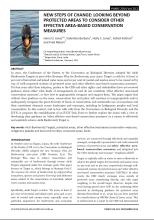Land Library
Bienvenue dans la bibliothèque du Land Portal. Explorez notre vaste collection de ressources en libre accès (plus de 74 000), comprenant des rapports, des articles scientifiques, des articles de recherche, des publications évaluées par des pairs, des documents juridiques, des vidéos et bien plus encore.
/ library resources
Showing items 1 through 9 of 15.On 24 November 2020 the Land Inequality Initiative (International Land Coalition, OXFAM, Welthungerhilfe) launched its new research report "Uneven Ground: Land Inequality at the Heart of Unequal Societies", and a series of groundbreaking studies that reveal new insights and data proving that lan
Land Degradation Neutrality is a new way of approaching land degradation that acknowledges that land and land-based ecosystems are affected by global environmental change as well as by local land use practices.
“Land matters” – more than ever! Can land be dealt with like other resources or – in terms of an economic perspective– forms of capital. Or does it attract particular meanings, sentiments, interests, acquisition strategies or social relations?
This Topic Guide covers: the trends in and drivers of large-scale land acquisition, and the associated costs, risks and benefits; the provision of and access to more accurate data on large-scale land acquisitions, and key international and regional initiatives to provide guidelines to enhance sec
The first years of the twenty-first century will be remembered for a global land rush of nearly unprecedented scale.
Large-scale land acquisitions have increased in scale and pace due to changes in commodity markets, agricultural investment strategies, land prices, and a range of other policy and market forces.
In 2010, the Conference of the Parties to the Convention on Biological Diversity adopted the Aichi Biodiversity Targets as part of the Strategic Plan for Biodiversity 2011-2020.
One of the most wellknown biofuel investments was that of Bioshape, which acquired approximately 34,000 ha in Kilwa District for the cultivation of jatropha.
The increasing importance of the Wildlife Management Areas (WMAs) in Tanzania, where 17 WMAs are now functioning and 22 others are in various stages of development, begs the question of what successes have been achieved and what challenges remain to be addressed if this Community-Based Conservati




